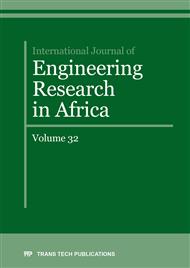[1]
A. Datta, and B.K. Mandal, A comprehensive review of biodiesel as an alternative fuel for compression ignition engine. Renewable and Sustainable Energy Review, 57(2016) 799-821.
DOI: 10.1016/j.rser.2015.12.170
Google Scholar
[2]
M.S. Ejaz, and J.A. Younis, A review of biodiesel as vehicular fuel. Renewable and Sustainable Energy Reviews, 12(9) (2008) 2484-2494.
DOI: 10.1016/j.rser.2007.06.001
Google Scholar
[3]
E. Westberg, Qualitative and quantitative analysis of biodiesel deposits formed on a hot metal surface, published M. Sc Thesis. Department of Physics, Chemistry and Biology, Institute of Technology, Linkoping University, (2013).
Google Scholar
[4]
G. Knothe, Analyzing biodiesel: Standards and other methods. Journal of the American Oil Chemists' Society, 83(10) (2006) 823-833.
DOI: 10.1007/s11746-006-5033-y
Google Scholar
[5]
BS EN 590: 2009 (2009), Automotive fuels. diesel. Requirements and test methods, London, Great Britain: BSI-British Standard Institution, (2009).
Google Scholar
[6]
Improvement on fossil diesel quality (punchng. com/nnpc-produce diesel-corps).
Google Scholar
[7]
A.A. Refaat, Different techniques for the production of biodiesel from waste vegetable oil. International Journal of Environmental, Science and Technology, 7(1) (2010) 183-213.
DOI: 10.1007/bf03326130
Google Scholar
[8]
Y.H. Tan, M.O. Abdullah, C.N. Hipolito, and Y.H. Taufiq-Yap, Waste ostrich and chicken-eggshells as heterogeneous base catalyst for biodiesel production from used cooking oil: catalyst characterization and biodiesel yield performance. Applied Energy, 2(2015).
DOI: 10.1016/j.apenergy.2015.09.023
Google Scholar
[9]
M.K. Lam, K.T. Lee, & Mohamed, A. R, Homogeneous, heterogeneous and enzymatic catalysis for transesterification of high free fatty acid oil (waste frying oil) to biodiesel: A review. Biotechnology Advances, 28 (4) (2010) 500-518.
DOI: 10.1016/j.biotechadv.2010.03.002
Google Scholar
[10]
A.V. Tomasevic, and S.S. Siler-Marinkovic, Methanolysis of used frying oil. Fuel Processing Technology, 81(2003) 6.
DOI: 10.1016/s0378-3820(02)00096-6
Google Scholar
[11]
A.B. Chhetri, K.C. Watts, and M.R. Islam, Waste frying oil as an alternate feedstock for biodiesel production. Energies, 1(2008) 3-18.
DOI: 10.3390/en1010003
Google Scholar
[12]
T.F. Adepoju, and O. Olawale, Acid catalyzed esterification of waste frying oil with high FFA for biodiesel production. Chemical and Process Engineering Research, 21(2014) 80-85.
Google Scholar
[13]
Tsai, W. t., Yang, J.M., Lai, C.W., Cheng, Y.H., Lin, C.C., & Yeh, C.W. (2006), Characterization and adsorption properties of eggshells and eggshell membrane. Bioresourse Technology, 121(2006) 167-173.
DOI: 10.1016/j.biortech.2005.02.050
Google Scholar
[14]
M.A. Olutoye, and B.H. Hameed, A highly active clay-based catalyst for the synthesis of fatty acid methyl ester from waste cooking palm oil. Applied Catalysis A: General. 450(2013) 57-62.
DOI: 10.1016/j.apcata.2012.09.049
Google Scholar
[15]
B.C. Yung and S. Gon, High activity of acid treated quail eggshell catalysts in the transetserification of palm oil with methanol. Bioresource Technology, 101(2010) 8515-8519.
DOI: 10.1016/j.biortech.2010.06.082
Google Scholar
[16]
M.A. Olutoye, O.D. Adeniyi, and A.S. Yusuff, Synthesis of biodiesel from palm kernel oil using mixed clay-eggshell heterogeneous catalysts. Iranica Journal of Energy and Environment, 7(2016) 308-314.
DOI: 10.5829/idosi.ijee.2016.07.03.14
Google Scholar
[17]
Z. Wei, C. Xu, and B. Li, Application of waste eggshell as low-cost solid catalyst for biodiesel production. Bioresource Technology, 100(2009) 2883–2885.
DOI: 10.1016/j.biortech.2008.12.039
Google Scholar
[18]
N. Viriya-empikul, P. Krasae, W. Nualpaeng, B. Yoosuk, and K. Faungnawakij, Biodiesel production over Ca-based solid catalysts derived from industrial wastes. Fuel, 92 (2012) 239-344.
DOI: 10.1016/j.fuel.2011.07.013
Google Scholar
[19]
B.S.J. Prakash, C.R. Reddy, P. Iyengar, and G. Nagendrappa, Esterificatiοn οf dicarbοxylic acids tο diesters οver Mn+ -mοntmοrillοnite clay catalysts, Catalysis Letter, 101(2005) 87-91.
DOI: 10.1007/s10562-004-3754-9
Google Scholar
[20]
M.A. Olutoye, S.W. Wong, L.H. Chin, M. Asif, and B.H. Hameed, Synthesis of fatty acid methyl esters via transesterification of waste frying oil by methanol with a barium-modified montmorillonite K10 catalyst. Renewable Energy, 86(2015) 392-398.
DOI: 10.1016/j.renene.2015.08.016
Google Scholar
[21]
A.S. Yusuff, Optimization of preparation conditions for composite catalyst derived from anthill and chicken eggshell using response surface methodology. PhD thesis: Federal University of Technology, Minna Nigeria (2016).
Google Scholar
[22]
B. Tesfa, F. Gu, R. Mishra and A. Ball, (2013), LHV prediction models and LHV effect on the performance of CI engine running with biodiesel blends. Energy Conversion and Management, 71(2013) 217-226.
DOI: 10.1016/j.enconman.2013.04.005
Google Scholar
[23]
N.E. M Elsolh The manufacture of biodiesel from the used vegetable oil. Published Master thesis, Faculty of Engineering at Kassel and Cairo Universities, Egypt, (2011).
Google Scholar
[24]
J. Coates, Interpretation of infrared spectra, A practical approach, Encyclopedia of analytical chemistry: New York, USA: John Wiley and Sons Ltd, (2000) 10815-10837.
Google Scholar
[25]
H. Li, S. Niu, C. Lu, S. Cheng, The stability evaluation of lime mud as heterogeneous catalyst in resisting CO2 and H2O for biodiesel production, Energy Conversion and management, 103(2015) 57-65.
DOI: 10.1016/j.enconman.2015.06.039
Google Scholar
[26]
P.K.S. Yadav, O. Singh, and R.P. Singh, Performance test of palm fatty acid biodiesel on compression ignition engine. Journal of Petroleum Technology and Alternative Fuels, 1(1) (2010) 1 -9.
Google Scholar
[27]
S. Jaichandar, and K. Annamalai, The status of biodiesel as an alternative fuel for diesel engine- An overview. Journal of Sustainable Energy & Environment, 2(2011) 71-75.
Google Scholar
[28]
R. Mythili, P. Venkatachalam, P. Subramaniam, and D. Uma, Production characterization and efficiency of biodiesel: a review. International Journal of Energy Research, John Wiley & Sons, Ltd, (2014).
Google Scholar
[29]
A. Demirbas, Biodiesel: a realistic fuel alternative for diesel engines. London: Springer-Verlag London Limited, (2008).
Google Scholar
[30]
A.M. Ashraful, H.H. Masjuki, M.A. Kalam, I.M.R. Fattah, S. Imtenan, S.A. Shahir, and H.M. Mobarak, Production and comparison of fuel properties, engine performance, and emission characteristics of biodiesel from various non-edible vegetable oils. A review. Energy Conversions Management, 80(2014).
DOI: 10.1016/j.enconman.2014.01.037
Google Scholar
[31]
A. Monyem, and J.H. Van Gerpen, The effect of biodiesel oxidation on engine performance and emission. Biomass Bioenergy, 20(2001) 317-325.
DOI: 10.1016/s0961-9534(00)00095-7
Google Scholar
[32]
S. Godiganur, C.H.S. Murthy, and R.P. Reddy, GBTA 5. 9 G2-1 Cummins engine performance and emission tests using methyl ester mahua (Madhuca indica) oil/diesel blends. Renewable Energy, 344(2009) 2172-2177.
DOI: 10.1016/j.renene.2008.12.035
Google Scholar
[33]
M.N. Nabi, S.M.N. Hoque and M.S. Akhtar, Karanja (Pongamia pinnata) biodiesel production in Bangladesh, characterization of Karanja biodiesel and its effect on diesel emissions. Fuel Processing Technology, 90(2009) 1080-1086.
DOI: 10.1016/j.fuproc.2009.04.014
Google Scholar


